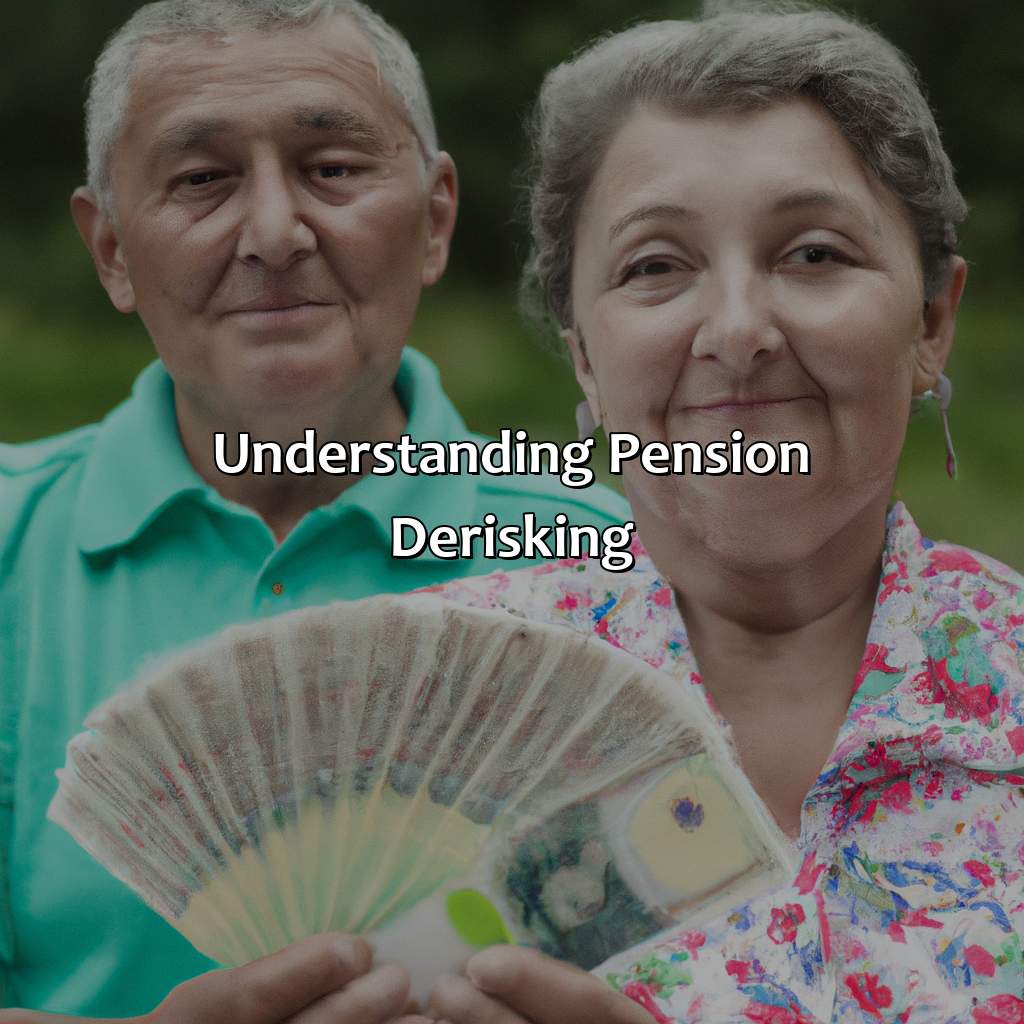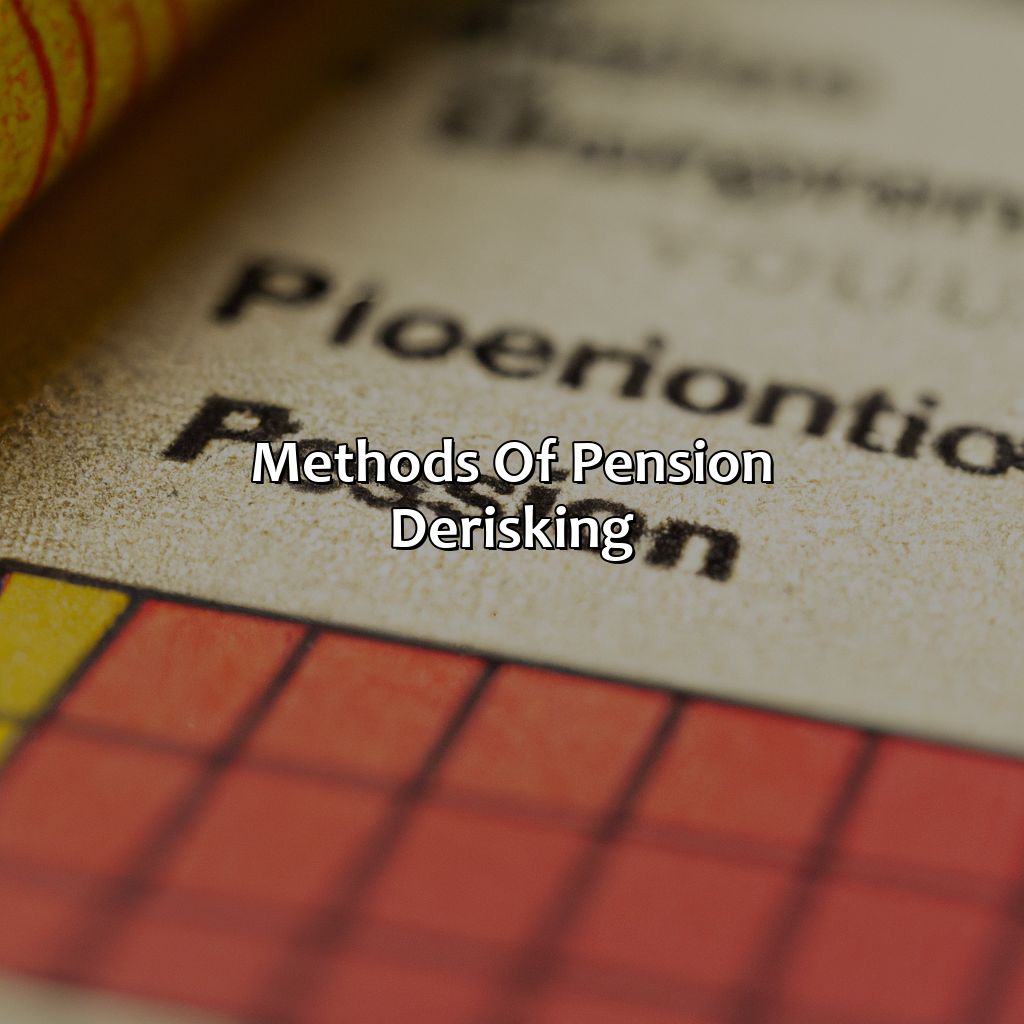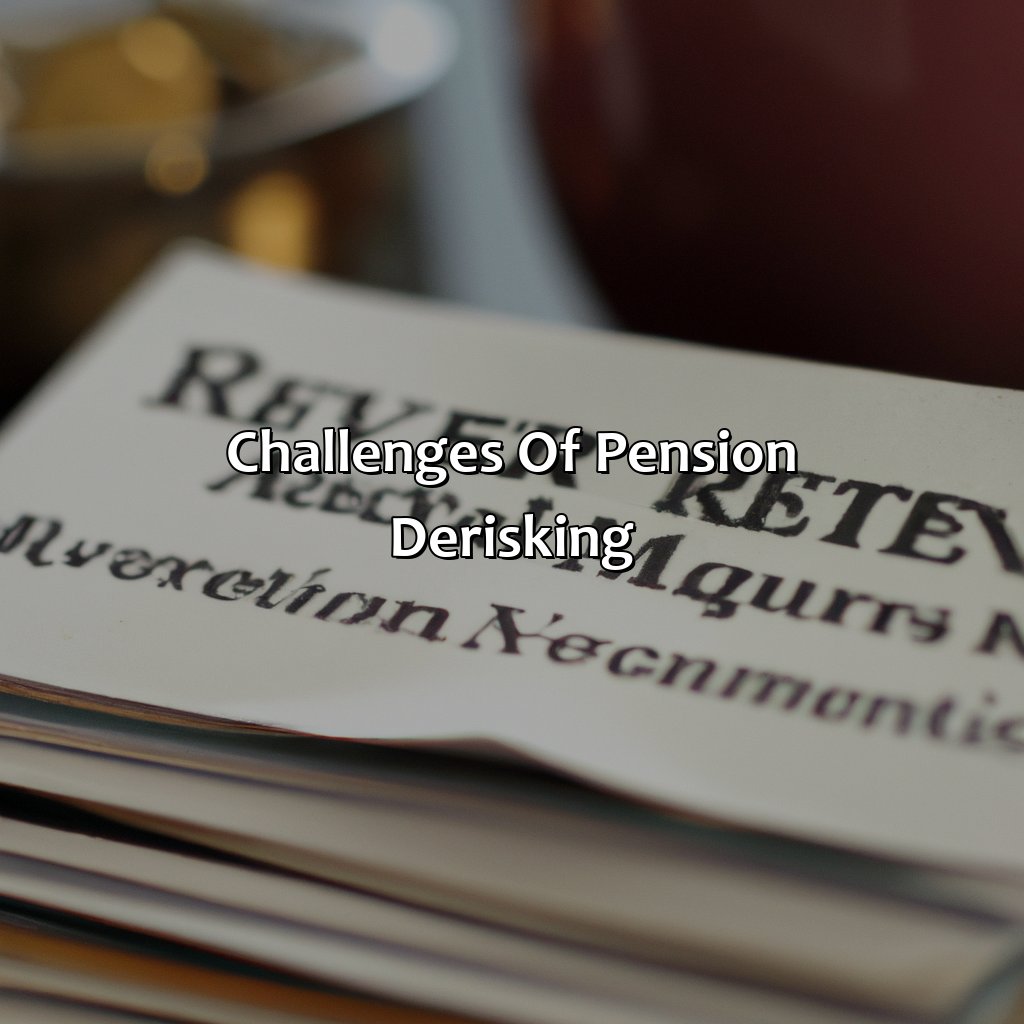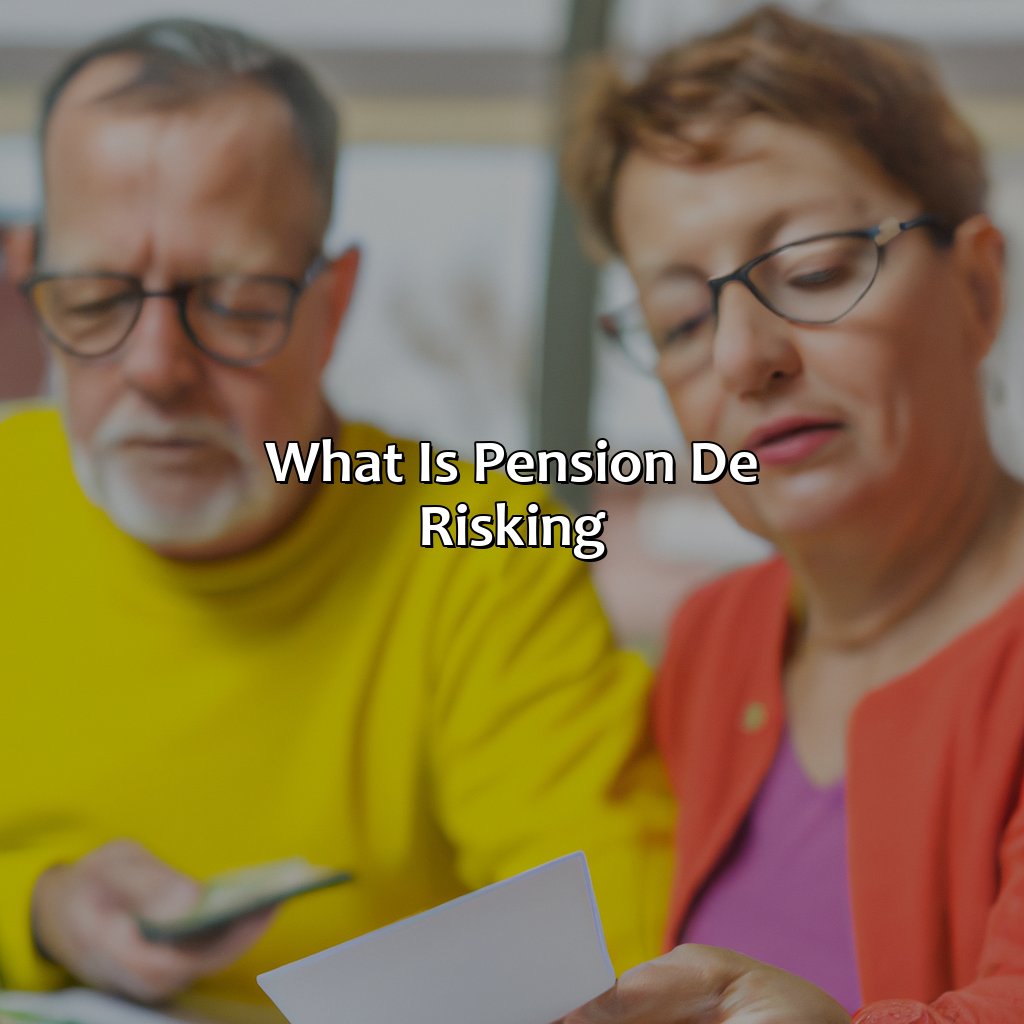What Is Pension De Risking?
Key takeaways:
- Pension de-risking is a strategy that aims to reduce the financial risk and volatility associated with pension plans.
- Pension de-risking methods include liability-driven investment (LDI), buyouts and buy-ins, and risk transfer.
- The benefits of pension de-risking include reducing financial risk and volatility, enhancing sponsor creditworthiness, and improving employee confidence and satisfaction; however, there are also challenges, such as high costs and complexity, regulatory compliance, and lack of understanding and awareness.
Tired of wondering how you will make ends meet after retirement? You’re not alone! Pension de-risking is a solution to optimize retirement savings – in this article, we’ll explore what it is and how it works.
Understanding Pension De-Risking
Let’s take a look at what pension de-risking is all about. We’ll define it and explain why it’s practiced. De-risking your company’s pension plan helps reduce financial risk and keep things running smoothly. In this section, we’ll give you a basic overview of pension de-risking. We’ll cover the definition and reasons for adoption.

Image credits: retiregenz.com by David Duncun
Definition of Pension De-Risking
Pension De-Risking refers to the act of mitigating financial risk associated with a pension plan. This process involves rebalancing assets and liabilities to manage long-term obligations efficiently. By reducing financial volatility, organizations safeguard against potential losses.
During Pension De-Risking, companies will often transfer some or all of their pension obligations to an insurance provider, such as an annuity. This process helps mitigate volatility while providing greater financial stability both for the company and its stakeholders.
One key detail is that by transferring pension obligations to an insurance provider, the company can focus on its core business instead of managing long-term obligations. This not only reduces financial risk but also enables businesses to focus on what they do best. If you’re unfamiliar with the term, you might be wondering, “what is a money purchase pension plan?”
In a similar tone, one true story relates to how a large corporation decided to reduce its pension risk by transferring some of its annuities to an insurance provider. Although this incurred a one-time cost, the decision provided significant peace of mind and allowed them to invest more resources in expanding their core business operations.
To learn more about commuted value of pension and pension de-risking, visit our website.
Pension de-risking: because who needs financial stability when you can live life on the edge.
Reasons for Pension De-Risking
Pension de-risking happens when pension plan sponsors reduce the financial risk and liability of their plans. The reasons behind pension de-risking are many, but some common factors include the volatility of asset markets, aging workforces, regulatory reforms and low-interest rates. Pension funds use a range of strategies to manage these risks, such as transferring liabilities to an insurance company or reducing the allocation towards high-risk investments.
Moreover, organizations need to meet regulatory requirements for funding the pension plans adequately. Addressing longevity risk is another reason why companies choose pension de-risking to secure themselves against changes in life expectancy. In some instances, organizations highlight the need for greater certainty over future cash flows and earnings reductions.
It is essential to note that in some cases, companies look to reduce volatility by moving manageable risks off their balance sheets through means such as buy-ins or buyouts from insurance companies. This shift results in less exposure to fluctuations in interest rates and market conditions.
In 2012, General Motors extended an offer urging vested participants to opt-out of its pensions scheme. The decision followed significant pushes by employers and policymakers for companies offering defined benefit pensions. The GM move gave employees a choice between accepting a lump-sum payout on retirement or remaining enrolled with constant annuity payments on top of Social Security benefits alongside healthcare coverage at no added cost. If you want to know more about how pensions are paid out, check out our website.
De-risking your pension? Just like playing Jenga, but with your retirement.
Methods of Pension De-Risking
Minimizing risk of your pension plan? You got options!
- To de-risk, try Liability-Driven Investment (LDI). It’ll align investments with obligations.
- Another way? Buyout or buy-in. That’ll shift responsibility to another entity.
- And then there’s Risk Transfer. It transfers pension plan risk to a third party.

Image credits: retiregenz.com by Harry Arnold
Liability-Driven Investment (LDI)
Investors engaging in strategies for Pension De-Risking, utilize Liability-Driven Investment (LDI) methodology. LDI investment techniques focus on reducing potential pension fund deficits by matching the expected cash flows and returns of the plan’s assets and projected liabilities. The primary aim is to reduce volatility associated with shortfall risk and help defend retirement funds.
This method requires effective communication and a distinct understanding of specific obligations from both sponsors and beneficiaries. As pension schemes change with time, risk management has become an increasingly vital aspect of planning. Employers use LDI techniques – Interest Rate and Inflation Swaps – or Profit-Sharing Agreements that enable them to handle their liabilities better.
Employers can avoid losses by reducing risks as this important consideration for managing retirement plans grows more acute over time. By using these strategies, companies can safeguard their employees’ future benefits.
In 2007, Barclays was one of the first organizations to implement such a plan in the United Kingdom, moving to de-risk part of its 62 million pension fund using liability-driven investment (LDI).
Who needs a retirement plan when you can just hope for a spontaneous buyout or buy-in?
Buyouts and Buy-ins
One method of pension de-risking involves transferring the risk of a pension scheme to an insurance company, known as a Buyout. Another method, referred to as Buy-in, involves the purchase of bulk annuities from an insurer by the pension fund itself. This allows for greater certainty in meeting future obligations. The key difference between these methods is who is responsible for paying out the pensions: the insurance company or the pension fund.
In addition, a buy-in can be partial or complete and may involve both insured and uninsured benefits. This approach lets trustees manage risks more strategically while providing a level of security to members. Optimally, this strategy would position funds where they have reliable coverage against all potential risks. To understand more about pension de-risking, it is important to know what a DB pension is.
In practice, a large UK educational institution recently completed a significant buy-in transaction with an insurance provider which covered more than 2,500 retirees with around 180 million in liabilities. The move allowed them to protect their retiring staff’s future incomes more affordably and prepare adequately for upcoming risks that could negatively impact their investments.
For those who don’t want to gamble their pension, risk transfer is like hiring a bodyguard for your retirement savings.
Risk Transfer
Ameliorating financial vulnerability, Pension Risk Transfer secures workers’ retirement income by way of transferring obligations to an insurance firm. Such a strategy is often employed by employers who want to mitigate risk and reduce their pension liabilities while increasing the predictability of future expenses.
Another well-known de-risking mechanism is “liability-driven investment” whereby investments are structured in such a way that they match future benefit outlays. LDI strategies can help reduce funding uncertainty resulting from market volatility, thus lowering underfunding risk.
If you want to know more about
Image credits: retiregenz.com by Yuval Jones
Reducing Financial Risk and Volatility
Minimizing Financial Uncertainty and Variability through Pension De-Risking
Diversification of the investment portfolio is an excellent way to minimize risk, but it does not provide complete protection against financial uncertainty. Pension de-risking aims to protect companies from unpredictable market changes while still providing financial security to their retirees. By transferring pension obligations to an insurer, employers can shift market and longevity risks away from their balance sheets.
Through a well-planned de-risking strategy, companies can save on administration costs and reduce the volatility of their pension liabilities. This eradicates much of the anxiety related to fluctuating interest rates, changing regulations, or even employees living longer than expected. Many organizations implement this strategy when they feel that they have underfunded their pension plans or during mergers and acquisitions. Learn more about why a pension is good for you.
The idea of pension risk transfer originated in the United Kingdom in 2007 with several large multinationals opting for this approach to reduce risks connected with their schemes. Ever since then, numerous firms across multiple sectors have integrated de-risking strategies into their growth plans because of it’s effectiveness in decreasing uncertainty around retirement funding obligations.
Secure that pension and you’ll be more credit-worthy than a billionaire in a turtleneck.
Enhancing Sponsor Creditworthiness
Securing financial obligations through pension de-risking increases the sponsor’s creditworthiness, yielding several benefits. Ensuring that all retirement and employee benefit plans are fully funded, reducing risks and financial burden on the company’s balance sheet. Mitigating pension plan risks enhances a sponsor’s solvency, allowing them to allocate resources for core business activities, increasing their budgetary stability for long-term growth.
Finally, employees can stop sweating their retirement savings and start sweating their CrossFit workouts thanks to pension de-risking.
Improving Employee Confidence and Satisfaction
The de-risking of pension plans can lead to a positive impact on the satisfaction and confidence levels of employees. By reducing the financial risk associated with pension plans, employees can feel more secure knowing that their retirement savings are protected. This can also lead to better employee retention rates, as they are more likely to stay with a company that offers stable and reliable pension benefits.
Furthermore, de-risking can also lead to increased transparency and communication between employers and employees regarding their retirement plans. Employers who implement de-risking strategies often provide regular updates and educational resources to help employees understand what is a pay as you go pension plan and their pension plan options.
Overall, it is important for companies to consider the benefits of pension de-risking not just for their own financial stability, but also for the peace of mind and satisfaction of their employees.
For instance, a recent study found that after implementing a de-risking strategy, a company saw an increase in employee satisfaction levels by 20%. Not only did this result in better retention rates, but it also led to improved productivity among employees who had less financial stress.
Why take the risk of de-risking your pension? Because who doesn’t enjoy a little bit of financial stress in their golden years?
Challenges of Pension De-Risking
Tackling pension de-risking can be expensive and complex. Compliance with regulations is also an issue. To gain more insight into these issues, we’ll explore each of the challenges. Then, you’ll have a better understanding of the difficulties faced in implementing pension de-risking strategy.

Image credits: retiregenz.com by Yuval Arnold
High Costs and Complexity
The daunting task of pension de-risking has a great impact on finances. A complex process with high costs, this endeavor involves a range of crucial steps like matching assets with liabilities to avoid any funding uncertainties or obligations. The residual monetary burden may require corporate sponsors to ponder over relinquishing the scheme.
Regulations, shmegulations – who needs ’em when you’ve got a pension to de-risk?
Regulatory Compliance
Compliance with the regulatory framework is a significant aspect of the de-risking process. This requires adherence to stringent guidelines, rules and regulations established by supervisory authorities in different jurisdictions. Ensuring regulatory compliance is critical to avoid penalties, reputational damage, or legal action that could arise as a consequence of non-compliance.
In addition to complying with regulatory requirements, pension funds plan sponsors may also need to analyze the various options available for transferring risk such as annuities or buyout solutions. In this section, we will examine some of the strategies and techniques commonly used for effective de-risking.
Pension plans must ensure that they meet their regulatory obligations due to the countless regulatory requirements and statutes in place worldwide. This involves enhanced disclosure and transparency about funding status and other relevant financial information. Plan sponsors should also ensure that any changes in plan design are communicated to plan members and unions appropriately. Additionally, ongoing monitoring of compliance levels is necessary to maintain an appropriate level of risk management.
Pro Tip: Regular review of a pension loan strategy is essential as regulations change frequently in most jurisdictions. A proactive approach allows businesses to stay ahead and foster trust with stakeholders while minimizing adverse outcomes associated with non-compliance. How does a pension loan work?
Most people would rather binge-watch Netflix than educate themselves on pension de-risking, and who can blame them? It’s about as thrilling as a PowerPoint presentation on tax law.
Lack of Understanding and Awareness
A limited understanding of Pension De-Risking is a challenging obstacle facing stakeholders. Many lack awareness of available options to mitigate pension liabilities and how the process works. This results in missed opportunities, regulatory penalties and lingering risks.
The lack of knowledge impacts corporate plans, pension funds and regulators alike, as they are tasked with ensuring that benefits promised to retirees will be delivered on time. Pension fund trustees often struggle to balance expected investment returns against liabilities due to variable market conditions.
Efforts to reduce or eliminate such risks require an in-depth understanding of the benefits of de-risking as well as its drawbacks. These include implications for cash flow, credit ratings and potential legal hurdles involved.
This challenge can be illustrated by a multinational corporation recently forced into bankruptcy. Their legacy defined benefit healthcare obligations placed an enormous financial burden on their balance sheet. Had they employed a de-risking strategy earlier, they might have avoided insolvency entirely.
Five Facts About Pension De-Risking:
Pension de-risking refers to the process of reducing risk in corporate pension plans. (Source: Investopedia)
Companies de-risk their pension plans to manage financial risks, such as market volatility and life expectancy changes. (Source: Willis Towers Watson)
Pension de-risking strategies include buying out plan participants with annuities, transferring liabilities to insurance companies, and investing in fixed-income assets. (Source: The Balance)
Pension de-risking can improve the financial stability of companies and allow them to focus on their core business operations. (Source: Deloitte)
Pension de-risking can have potential consequences for plan participants, such as reduced benefits and increased reliance on the Pension Benefit Guaranty Corporation (PBGC). (Source: U.S. Government Accountability Office)
FAQs about What Is Pension De Risking?
What is pension de risking?
Pension de risking refers to the process of managing a pension fund’s investment risks in order to reduce the impact of financial market turbulence on the fund’s overall performance.
Why is pension de risking important?
Pension de risking is important because it can help to protect the long-term financial security of pension fund beneficiaries. It can also help to reduce the financial risks faced by companies that sponsor pension funds.
How is pension de risking achieved?
Pension de risking is typically achieved through a combination of investment strategies and financial instruments, such as hedging, liability-driven investing, and annuity purchases.
Who is responsible for pension de risking?
Pension de risking is the responsibility of pension fund trustees, who have a legal obligation to manage pension fund investments in the best interests of beneficiaries.
What are the potential benefits of pension de risking?
The potential benefits of pension de risking include reduced investment risk, improved long-term financial stability, and improved funding levels.
Are there any risks associated with pension de risking?
There are some risks associated with pension de risking, including the potential for reduced investment returns, increased transaction costs, and the risk of selecting inappropriate investment strategies. However, these risks can be mitigated through careful planning and management.
 Checkout this IRS Loophole
Checkout this IRS Loophole 
